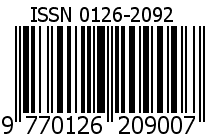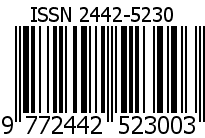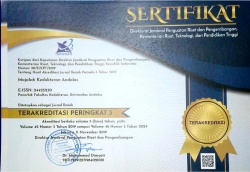Perbedaan Rerata Kadar Ferritin dan Kadar Malondialdehid pada Darah Tali Pusat Neonatus Normal dan Intrauterine Growth Restriction
Abstract
Tujuan : Untuk mengetahui perbedaan kadar ferritin dan malondialdehid pada darah tali pusat neonatus normal dan neonatus Intrauterine growth restriction (IUGR). Metode : analitik observasional dengan desain cross sectional comparative. Penelitian dilakukan di RSUP M.Djamil, RS Unand dan RS Hermina di kota Padang dan Laboratorium Biomedik Fakultas Kedokteran Universitas Andalas. Sampel berjumlah 60 neonatus terdiri dari 2 kelompok, yaitu neonatus normal dan neonatus Intrauterine growth restriction (IUGR) dengan teknik consecutive sampling. Pemeriksaan serum ferritin diperiksa menggunakan metode ELISA dan kadar malondialdehid diperiksa dengan metode TBARS. Analisis data menggunakan uji normalitas Kolmogorov Smirnov (p >0,05). Uji hipotesis menggunakan t-test independen dan mann-whitney. Hasil : rerata serum ferritin pada kelompok neonatus IUGR adalah 110 ± 68,12 ng/ml dan pada neonatus normal 150 ± 75,72 ng/ml. Kadar malondialdehid pada kelompok neonatus IUGR adalah 2,91 nmol/mL, dan pada neonatus normal 2,25 nmol/mL. Uji statistik didapatkan bahwa terdapat perbedaan bermakna kadar ferritin dan malondialdehid pada darah tali pusat neonatus normal dengan neonatus IUGR dengan nilai p = 0,012 dan p = 0,0001. Kesimpulan : terdapat perbedaan bermakna kadar ferritin dan malondialdehid pada neonatus normal dan neonatus Intrauterine growth restriction (IUGR)
Keywords
Full Text:
PDFReferences
Priante E, Verlato G, Giordano G, Stocchero M, Visentin S, Mardegan V, et al. Intrauterine growth restriction: New insight from the metabolomic approach. Metabolites. 2019;9(11).
Kesavan K, Devaskar SU. Intrauterine Growth Restriction: Postnatal Monitoring and Outcomes. Pediatr Clin North Am [Internet]. 2019;66(2):403–23. Available from: https://doi.org/10.1016/j.pcl.2018.12.009
Ganju DS. Maternal anaemia, intra uterine growth restriction and neonatal outcomes. Int J Clin Obstet Gynaecol. 2020;4(4):152–5.
Malhotra A, Allison BJ, Castillo-Melendez M, Jenkin G, Polglase GR, Miller SL. Neonatal morbidities of fetal growth restriction: Pathophysiology and impact. Front Endocrinol (Lausanne). 2019;10(FEB).
Sharma D, Shastri S, Sharma P. Intrauterine Growth Restriction: Antenatal and Postnatal Aspects. Clin Med Insights Pediatr. 2016;10:CMPed.S40070.
Armengaud JB, Yzydorczyk C, Siddeek B, Peyter AC, Simeoni U. Intrauterine growth restriction: Clinical consequences on health and disease at adulthood. Reprod Toxicol [Internet]. 2021;99:168–76. Available from: https://doi.org/10.1016/j.reprotox.2020.10.005
Rodríguez-Rodríguez P, Ramiro-Cortijo D, Reyes-Hernández CG, Lopez de Pablo AL, González MC, Arribas SM. Implication of oxidative stress in fetal programming of cardiovascular disease. Front Physiol. 2018;9:602.
Rak K, Łoźna K, Styczyńska M, Bobak Ł, Bronkowska M. Oxidative stress at birth is associated with the concentration of iron and copper in maternal serum. Nutrients. 2021;13(5).
Bakoyiannis I, Gkioka E, Daskalopoulou A, Korou LM, Perrea D, Pergialiotis V. An explanation of the pathophysiology of adverse neurodevelopmental outcomes in iron deficiency. Rev Neurosci. 2015;26(4):479–88.
Fretham SJB, Carlson ES, Georgieff MK. Neuronal-specific iron deficiency dysregulates mammalian target of rapamycin signaling during hippocampal development in nonanemic genetic mouse Models1,2. J Nutr. 2013;143(3):260–6.
Akkurt MO, Akkurt I, Altay M, Coskun B, Erkaya S, Sezik M. Maternal serum ferritin as a clinical tool at 34–36 weeks’ gestation for distinguishing subgroups of fetal growth restriction. J Matern Neonatal Med. 2017;30(4):452–6.
Schoots MH, Gordijn SJ, Scherjon SA, van Goor H, Hillebrands JL. Oxidative stress in placental pathology [Internet]. Vol. 69, Placenta. Elsevier Ltd; 2018. 153–161 p. Available from: https://doi.org/10.1016/j.placenta.2018.03.003
Mannaerts D, Faes E, Cos P, Briedé JJ, Gyselaers W, Cornette J, et al. Oxidative stress in healthy pregnancy and preeclampsia is linked to chronic inflammation, iron status and vascular function. PLoS One. 2018;13(9):1–14.
Khoubnasab Jafari M, Ansarin K, Jouyban A. Comments on “use of malondialdehyde as a biomarker for assesing oxidative stress in different disease pathologies: A review.” Iran J Public Health. 2015;44(5):714–5.
Chandra N, Mehndiratta M, Banerjee BD, Guleria K, Tripathi AK. Idiopathic fetal growth restriction: repercussion of modulation in oxidative Stress. Indian J Clin Biochem. 2016;31(1):30–7.
DePalma RG, Hayes VW, O’Leary TJ. Optimal serum ferritin level range: Iron status measure and inflammatory biomarker. Metallomics. 2021;13(6):mfab030.
Georgieff MK. Iron deficiency in pregnancy. Am J Obstet Gynecol. 2020;223(4):516–24.
Morales González E, Contreras I, Estrada JA. Effect of iron deficiency on the expression of insulin-like growth factor-II and its receptor in neuronal and glial cells. Neurol (English Ed [Internet]. 2014;29(7):408–15. Available from: http://dx.doi.org/10.1016/j.nrleng.2013.10.017
Joo EH, Kim YR, Kim N, Jung JE, Han SH, Cho HY. Effect of endogenic and exogenic oxidative stress triggers on adverse pregnancy outcomes: Preeclampsia, fetal growth restriction, gestational diabetes mellitus and preterm birth. Int J Mol Sci. 2021;22(18):10122.
Schoots MH, Gordijn SJ, Scherjon SA, van Goor H, Hillebrands JL. Oxidative stress in placental pathology [Internet]. Vol. 69, Placenta. Elsevier Ltd; 2018. 153–161 p. Available from: https://doi.org/10.1016/j.placenta.2018.03.003





















